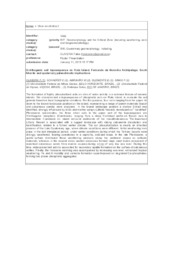Ornithogenic soil toposequence on Rata island, Fernando de Noronha archipelago, south atlantic and quaternary paleoclimatic implications.
Ornithogenic soil toposequence on Rata island, Fernando de Noronha archipelago, south atlantic and quaternary paleoclimatic implications.
Author(s): OLIVEIRA, F.; SCHAEFER, C.; ABRAHÃO, W.; ALMEIDA, E. de P. C.; SIMAS, F.
Summary: The formation of highly phosphatized soils on sites of avian activity is a common feature of oceanic islands. We characterized a toposequence of phosphatic soils on Rata Island, to evaluate the soil genesis based on local topographic variations. For this purpose, four soils ranging from the upper hill down to the lowest landscape position on the island, representing a range of parent materials (basalt and calcareous sands), were analyzed. In the lowest landscape position a shallow Entisol was identified, strongly influenced by birds and marine sprays (Litholic Neosol), developed on " karstified" Pleistocene calcarenites; the three other soils in the upper part of the toposequence are Ornithogenic Inceptsols (Cambisols), ranging from a deep Cambisol profile on Basalt lava to intermediate Cambisols on mixed colluvial sediments of the basalt/calcareous. The lowermost Litholic Neosol is associated with a rugged landscape with strong calcarenite dissolution and karstification, related to a former wetter climate. The soil phosphatization is clearly an inherited process of the Late Quaternary age, when climate conditions were different. Initial weathering took place in the last interglacial period, under wetter conditions during which the Tertiary basalts were strongly weathered, leaving corestones in a saprolitic, oxidized mass. In the late Pleistocene, a gentle surface distributed these weathering products along the pediment slopes as colluvial materials, whereas in the coastal areas aeolian processes formed large sand dunes composed of reworked calcareous sands from marine sources during a time of very low sea level. During this time, widespread bird activity accounted for secondary apatite formation on the surface of calcareous oolites. Finally, the Holocene warming was accompanied by increasing sea level, enhanced tropical weathering, Fe and Al mobility and variscite formation superimposed on degraded Ca-phosphates, forming two phase phosphatic aggregates.
Publication year: 2013
Types of publication: Abstract in annals or event proceedings
Unit: Embrapa Soils
Keywords: Fernando de Noronha Archipelago, Ornithogenic soil
Observation
Some of Embrapa's publications are published as ePub files. To read them, use or download one of the following free software options to your computer or mobile device. Android: Google Play Books; IOS: iBooks; Windows and Linux: Calibre.
Access other publications
Access the Agricultural Research Database (BDPA) to consult Embrapa's full library collection and records.
Visit Embrapa Bookstore to purchase books and other publications sold by Embrapa.

